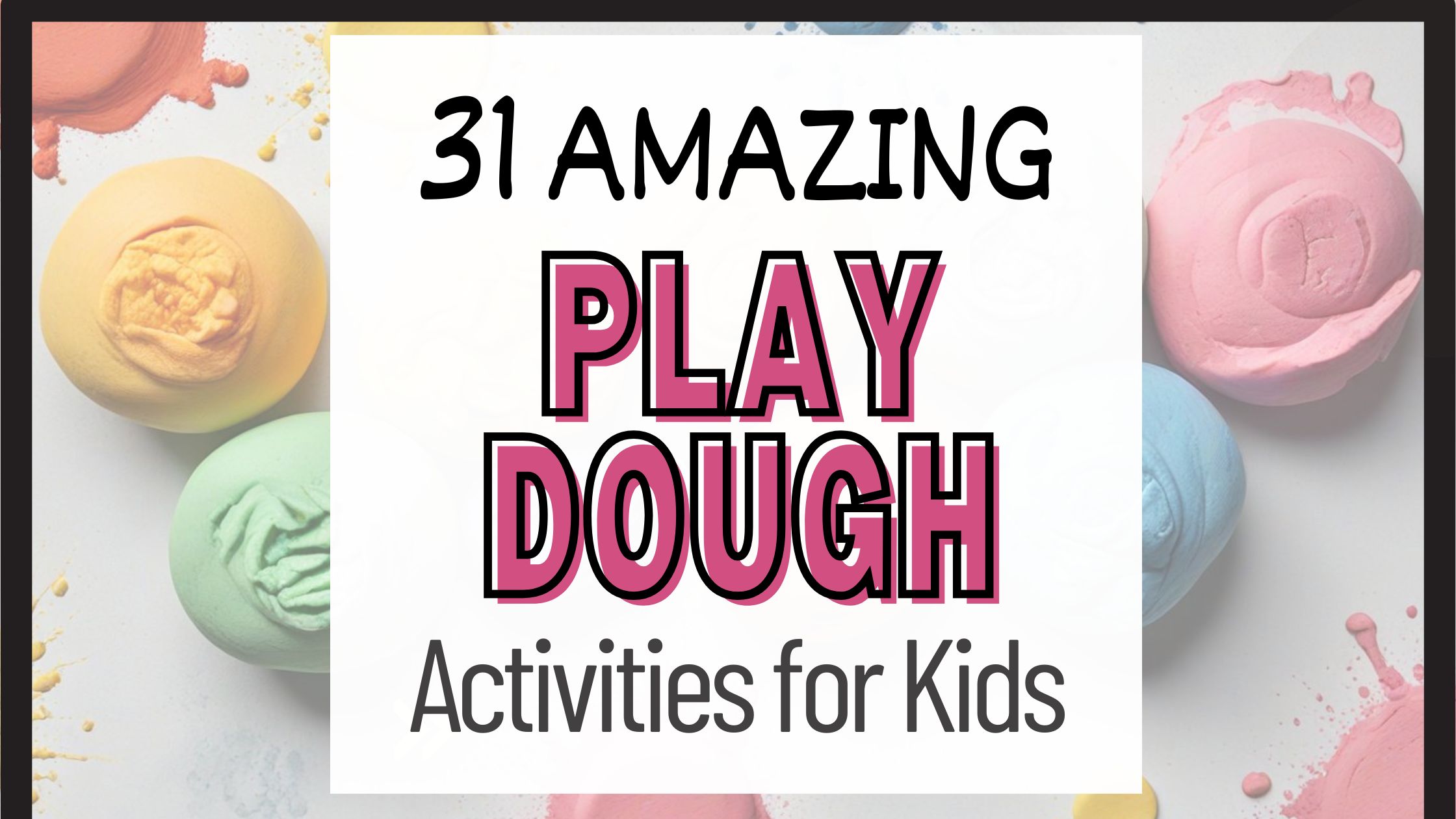As a kid I loved to play with play doh. I remember I used to leave small play doh animals on my fathers window still whenever I visited was a kid. (He still has them!)
Just in case you look for a gift for grandparents ;).
If you’re a parent, teacher, or caregiver, you probably already know that sensory play is a magical tool for helping kids learn and grow. Sensory dough, in particular, is an amazing medium that offers endless opportunities for creative exploration and learning. Whether it’s developing fine motor skills, encouraging imaginative play, or teaching basic math concepts, sensory dough can do it all! In this post, I’ll share my top 10 sensory dough activities for kids that are not only fun but also educational. Let’s dive in! 🌟
- 1. Sensory Dough Shape Creation
- 2. Sensory Dough Counting Caterpillar 🐛
- 3. Sensory Dough Town
- 4. Sensory Dough Mazes
- 5. Alphabet Tracing
- 6. Seasonal Sensory Dough Creations 🍁
- 7. Color Mixing Magic
- 8. DIY Fossil Dig
- 9. Sensory Dough Birthday Cake Creation 🎂
- 10. Play Dough Pizza Party 🍕
- 11. DIY Play Dough Bakery 🍪
- 12. Rainbow Sensory Dough 🌈
- 13. Space Adventure
- 14. Sensory Dough Flower Garden 🌸
- 15. Pattern Play
- 16. Sensory Dough Ocean Adventure 🌊
- 17. Sensory Dough Puzzle Pieces
- 18. Underwater Volcano Eruption 🌋
- 19. Play Dough Dinosaurs 🦕
- 20. Sensory Dough Roads and Tracks
- 21. Play Dough Faces
- 22. Play Dough Snowmen ⛄
- 23. Sensory Dough Stamping Art
- 24. Monster Sensory Dough Creations 👾
- 25. Play Dough Ice Cream Shop 🍦
- 26. Play Dough Jewelry Making 💍
- 27. Play Dough Fruit Basket 🍇
- 28. Weather Sensory Dough Scenes ☀️🌧️
- 29. Play Dough Insect World 🐞
- 30. Animal Homes
- 31. Play Dough Cupcakes 🧁
- Answering Your Top Sensory Dough Questions 📋
- Conclusion
- Pin it for Later
- Latest Posts:
1. Sensory Dough Shape Creation
This classic sensory dough activity is perfect for little ones who are just learning about shapes. Set up a “shape creation station” where your child can use cookie cutters, rolling pins, and their hands to form different shapes like circles, squares, and triangles.
Learning Benefits: Shape recognition, fine motor skills, and hand-eye coordination.
What You’ll Need: Sensory dough, shape cookie cutters, rolling pins.
How to Play: Encourage your child to create different shapes using the tools provided. Discuss the properties of each shape, like the number of sides and corners.
2. Sensory Dough Counting Caterpillar 🐛
Turn math into a fun game by creating a counting caterpillar with sensory dough! This activity is great for toddlers and preschoolers who are just beginning to learn how to count.

Learning Benefits: Counting, number recognition, and sequencing.
What You’ll Need: Sensory dough in various colors, googly eyes (optional).
How to Play: Roll small dough balls and line them up to form a caterpillar. Number each segment from 1 to 10 (or higher) and have your child count as they go.
For more math fun, explore The Simple Guide to Teaching Math with Sensory Dough—Get Ready to Be Amazed!
3. Sensory Dough Town
Build an entire town out of sensory dough! This is an excellent activity for encouraging creative play and storytelling.
Learning Benefits: Creativity, fine motor skills, and imaginative play.
What You’ll Need: Sensory dough, toy cars, small figurines, building blocks.
How to Play: Use the dough to create roads, houses, trees, and more. Then, let your child play with their toy cars and figures in the town they’ve built.
4. Sensory Dough Mazes
Challenge your child’s problem-solving skills by creating mazes out of sensory dough. This activity is not only fun but also helps develop critical thinking.
Learning Benefits: Problem-solving, hand-eye coordination, and spatial awareness.
What You’ll Need: Sensory dough, small balls or marbles.
How to Play: Roll out the dough into long snakes and form them into a maze on a flat surface. Have your child navigate a small ball through the maze.
5. Alphabet Tracing
Perfect for early learners, this activity combines the tactile experience of sensory dough with learning to write letters.
Learning Benefits: Letter recognition, fine motor skills, and early writing skills.
What You’ll Need: Sensory dough, alphabet cards or printouts.
How to Play: Roll the dough into rolls and use alphabet cards as templates for forming the letters. Your child can make the letters using their fingers or a tool.
Here is a free ABC Letter Tracing Printable:

6. Seasonal Sensory Dough Creations 🍁
Celebrate the changing seasons by creating themed sensory dough activities. Whether it’s making snowflakes for winter or flowers for spring, this activity helps kids connect with nature and the world around them.
Learning Benefits: Understanding of seasons, creativity, and fine motor skills.
What You’ll Need: Sensory dough, seasonal cookie cutters or templates (e.g., leaves, snowflakes, flowers).
How to Play: Use the cutters or templates to create seasonal shapes. Decorate them with small beads or glitter for added fun.
7. Color Mixing Magic
Help your child learn about colors and color theory with this simple yet fascinating activity. Mixing different colors of sensory dough can lead to some delightful discoveries!
Learning Benefits: Understanding of color theory, creativity, and fine motor skills.
What You’ll Need: Sensory dough in primary colors (red, yellow, blue).
How to Play: Encourage your child to mix two different colors of dough together and observe what new color is created. For example, mixing blue and yellow to make green.
8. DIY Fossil Dig
Turn your little ones into paleontologists by hiding small toys or “fossils” in the sensory dough. This activity is not only fun but also a great way to introduce basic science concepts.
Learning Benefits: Science concepts, fine motor skills, and problem-solving.
What You’ll Need: Sensory dough, small plastic dinosaurs or toys, tools for digging (like plastic knives or spoons).
How to Play: Hide the small toys in the dough and let your child dig them out. You can even talk about what fossils are and how they are discovered!
9. Sensory Dough Birthday Cake Creation 🎂

Let your child’s imagination run wild by creating their very own birthday cake out of sensory dough! This is perfect for pretend play and developing creativity. Or for your next birthday party. (Maybe I am stressing about my boys birthday a bit too much lol)
Learning Benefits: Creativity, fine motor skills, and imaginative play.
What You’ll Need: Sensory dough in various colors, small beads or buttons for decorations, candles (optional).
How to Play: Have your child stack layers of dough to form a cake, then decorate it with beads, buttons, or small toys. Add candles for an extra touch!
Pair this with a Sensory Dough Birthday Party Ideas to create a magical birthday-themed play session!
10. Play Dough Pizza Party 🍕
Let your child become a little chef and create their very own play dough pizza. This activity is perfect for role-playing and learning about food.
Learning Benefits: Role-playing, creativity, and fine motor skills.
What You’ll Need: Brown or beige sensory dough for the crust, red for sauce, and various colors for toppings (e.g., green for peppers, white for cheese).
How to Play: Have your child roll out the dough to form a pizza base and add the toppings they like. They can even “bake” it in a pretend oven!
11. DIY Play Dough Bakery 🍪
Encourage your little baker to whip up some pretend treats! This sensory dough activity is perfect for role-playing and creativity.
- What You’ll Need: Sensory dough in various colors, cookie cutters, small rolling pins, play dishes.
- How to Play: Have your child use the dough to create cookies, cakes, and other treats. They can “bake” them in a play oven or serve them on little plates.
- Learning Benefits: Creativity, fine motor skills, and role-playing.
12. Rainbow Sensory Dough 🌈

Brighten up your child’s day with a rainbow of colors! This activity is perfect for teaching color recognition and creating vibrant art.
- What You’ll Need: Sensory dough in multiple colors, rolling pins.
- How to Play: Have your child roll out the different colors of dough and layer them to create a rainbow. They can also mix colors to see what new shades they can create.
- Learning Benefits: Color recognition, creativity, and fine motor skills.
13. Space Adventure
Blast off into space with this out-of-this-world sensory dough activity! Perfect for little astronauts, this idea combines play with learning about the solar system.
- What You’ll Need: Black or dark blue sensory dough, star-shaped cutters, small toy planets, and astronauts.
- How to Play: Spread out the dough as a backdrop and place stars, planets, and astronauts on it. Your child can create their own space adventure and learn about the solar system.
- Learning Benefits: Understanding of space, imaginative play, and fine motor skills.
14. Sensory Dough Flower Garden 🌸
Celebrate spring or simply enjoy the beauty of flowers with this sensory dough garden activity.

- What You’ll Need: Green sensory dough for grass, various colors for flowers, flower-shaped cutters.
- How to Play: Have your child roll out the green dough to create a grassy base. Then, they can use the cutters to create flowers to plant in their garden.
- Learning Benefits: Creativity, color recognition, and understanding of nature.
15. Pattern Play
Teach your child about patterns and sequencing with this simple yet educational activity.
- What You’ll Need: Sensory dough, small beads or buttons in different colors.
- How to Play: Roll out the dough and press beads or buttons into it to create a pattern. Start with simple AB patterns and gradually make them more complex as your child gets the hang of it.
- Learning Benefits: Pattern recognition, sequencing, and fine motor skills.
16. Sensory Dough Ocean Adventure 🌊
Take your child on an underwater adventure by creating an ocean scene with sensory dough. This activity is fantastic for imaginative play and learning about marine life.
- What You’ll Need: Blue sensory dough, small sea animal toys, shells, pebbles.
- How to Play: Spread the blue dough to represent the ocean floor. Add shells, pebbles, and sea animals to create an underwater scene. Your child can explore and even make up stories about the creatures!
- Learning Benefits: Imaginative play, knowledge of marine life, and fine motor skills.
17. Sensory Dough Puzzle Pieces
Turn your sensory dough into a puzzle! This activity helps develop problem-solving skills and spatial awareness.
- What You’ll Need: Sensory dough, a puzzle template (print out a simple shape or design).
- How to Play: Roll out the dough and cut out pieces using a puzzle template. Mix up the pieces and challenge your child to put them back together.
- Learning Benefits: Problem-solving, spatial awareness, and fine motor skills.
18. Underwater Volcano Eruption 🌋
Combine sensory play with a bit of science by creating an underwater volcano that “erupts” in sensory dough!
- What You’ll Need: Red, orange, and yellow sensory dough, a small container, baking soda, and vinegar.
- How to Play: Form a volcano shape with the dough around the container. Add a bit of baking soda inside, then pour in vinegar to make it erupt!
- Learning Benefits: Science concepts, creativity, and sensory exploration.
19. Play Dough Dinosaurs 🦕
Bring dinosaurs back to life with this sensory dough activity. Perfect for little paleontologists!
- What You’ll Need: Sensory dough, dinosaur-shaped cutters, small dinosaur toys.
- How to Play: Use the cutters to create dough dinosaurs, or shape them by hand. Your child can also press the dinosaur toys into the dough to make fossil imprints.
- Learning Benefits: Knowledge of dinosaurs, imaginative play, and fine motor skills.
20. Sensory Dough Roads and Tracks
Create roads, tracks, and pathways with sensory dough and let your child explore with toy cars and trains.
- What You’ll Need: Sensory dough, toy cars, trains, or trucks.
- How to Play: Roll out the dough into long strips to form roads or tracks. Your child can drive their cars or trains along these paths, creating a mini city or race track.
- Learning Benefits: Imaginative play, motor skills, and creativity.
21. Play Dough Faces
This activity is fantastic for teaching emotions and expressions while being creative with sensory dough.
- What You’ll Need: Sensory dough in various colors, small beads, googly eyes, and other small items.
- How to Play: Shape the dough into faces and use beads, buttons, or other items to create eyes, noses, mouths, and other features. You can talk about different emotions and how they are expressed.
- Learning Benefits: Understanding of emotions, creativity, and fine motor skills.
22. Play Dough Snowmen ⛄
Bring the winter fun indoors by making snowmen with sensory dough. No snow required!
- What You’ll Need: White sensory dough, small buttons, sticks, and beads for decorating.
- How to Play: Roll the dough into three balls to form a snowman. Use buttons, sticks, and beads to add eyes, noses, arms, and scarves.
- Learning Benefits: Creativity, fine motor skills, and role-playing.
23. Sensory Dough Stamping Art
Turn sensory dough into a canvas for stamping art! This activity combines art with sensory play.
- What You’ll Need: Sensory dough, various stamps or textured objects (like leaves or lace).
- How to Play: Press the stamps or objects into the dough to create interesting patterns and designs. Your child can experiment with different textures and colors.
- Learning Benefits: Creativity, sensory exploration, and fine motor skills.
24. Monster Sensory Dough Creations 👾
Let your child’s imagination run wild by creating silly or spooky monsters out of sensory dough. This is a great activity for Halloween or just a fun afternoon!
- What You’ll Need: Sensory dough in various colors, googly eyes, pipe cleaners, small beads.
- How to Play: Shape the dough into different monster forms and use the googly eyes, pipe cleaners, and beads to add features like eyes, arms, and mouths.
- Learning Benefits: Creativity, imaginative play, and fine motor skills.
25. Play Dough Ice Cream Shop 🍦
Set up a pretend ice cream shop where your child can create their own flavors and serve them up!
- What You’ll Need: Sensory dough in pastel colors, ice cream scoops, small cones or bowls.
- How to Play: Have your child roll the dough into scoops of ice cream and place them on cones or in bowls. They can mix and match colors to create different “flavors” and serve them to family members.
- Learning Benefits: Role-playing, creativity, and fine motor skills.
26. Play Dough Jewelry Making 💍
Turn sensory dough into beads and jewelry! This activity is perfect for little fashionistas.
- What You’ll Need: Sensory dough, straws or toothpicks, string.
- How to Play: Roll the dough into small balls or other shapes, then poke a hole through each one with a straw or toothpick. Let them dry slightly, then thread them onto the string to make necklaces, bracelets, or rings.
- Learning Benefits: Fine motor skills, creativity, and hand-eye coordination.
27. Play Dough Fruit Basket 🍇
Teach your child about different fruits by creating a sensory dough fruit basket. This activity is both fun and educational.
- What You’ll Need: Sensory dough in various colors, fruit-shaped cutters or your own hands to shape the fruit.
- How to Play: Shape the dough into different fruits like bananas, apples, and grapes. Arrange them in a pretend basket.
- Learning Benefits: Knowledge of fruits, color recognition, and fine motor skills.
28. Weather Sensory Dough Scenes ☀️🌧️
Teach your child about different weather conditions by creating sensory dough scenes representing sun, rain, clouds, and more.
- What You’ll Need: Sensory dough in appropriate colors (e.g., yellow for the sun, blue for rain), cotton balls for clouds.
- How to Play: Help your child create scenes that represent different types of weather. For example, they can make a sunny day with a big yellow sun or a rainy day with raindrops and clouds.
- Learning Benefits: Understanding of weather, creativity, and fine motor skills.
29. Play Dough Insect World 🐞
Explore the world of insects by creating them out of sensory dough. This is a fun way to learn about bugs and their characteristics.
- What You’ll Need: Sensory dough in various colors, small beads or pipe cleaners for details.
- How to Play: Have your child create different insects like ladybugs, butterflies, or ants out of the dough. They can add details like wings or antennae using beads and pipe cleaners.
- Learning Benefits: Knowledge of insects, creativity, and fine motor skills.
30. Animal Homes
Help your child learn about different animal habitats by creating them with sensory dough. This activity is both fun and educational.
- What You’ll Need: Sensory dough, small animal figurines or your own creations.
- How to Play: Shape the dough into different homes like bird nests, beehives, or bear caves. Place the appropriate animals in their homes and discuss why they live there.
- Learning Benefits: Knowledge of animal habitats, creativity, and fine motor skills.
31. Play Dough Cupcakes 🧁
Let your child become a pastry chef by making play dough cupcakes. This is perfect for pretend play and celebrating any occasion.
- What You’ll Need: Sensory dough in various colors, cupcake liners, small beads or buttons for decorations.
- How to Play: Roll the dough into balls and place them in the cupcake liners. Decorate the cupcakes with beads or buttons to represent sprinkles.
- Learning Benefits: Role-playing, creativity, and fine motor skills.
Answering Your Top Sensory Dough Questions 📋
Before wrapping up, let’s address some of the most common questions I get about sensory dough!
1. How long does sensory dough last?
- Answer: Sensory dough can last anywhere from a few days to several months, depending on how it’s stored. Keep it in an airtight container in a cool, dry place to extend its lifespan (aka the fridge). Adding a bit of oil can also help keep it soft and pliable.
2. Can you make sensory dough at home?
- Answer: Absolutely! Homemade sensory dough is easy to make with common kitchen ingredients like flour, salt, water, and oil. You can even add food coloring, glitter, or essential oils for extra sensory stimulation. Here is a simple sensory dough recipe.
3. Is sensory dough safe for toddlers?
- Answer: Yes, sensory dough is generally safe for toddlers, especially if you make it at home and know exactly what’s in it. However, always supervise young children during play to ensure they don’t put it in their mouths… or nose.
4. Can you color sensory dough?
- Answer: Yes, you can color sensory dough using food coloring, liquid watercolors, or even natural dyes like beet juice or turmeric.
5. How do you clean up after sensory dough play?
- Answer: Clean up is easy! Just pick up any large pieces and wipe the area with a damp cloth. If the dough gets stuck in fabrics or carpets, let it dry first and then brush or vacuum it out.
Conclusion
And there you have it—30 more exciting sensory dough activities that are perfect for kids! Whether you’re teaching math, exploring nature, or just having fun, these activities offer endless opportunities for learning and play. Remember to check out our other sensory play ideas, like Layered Sensory Bottles and Farm-Themed Sensory Bins, to keep the creativity flowing. Happy crafting!
Pin it for Later

📌 Pin now, read later! Save our guide on Pinterest and share the joy of sensory play with your friends and family. Which sensory dough activity will you try first? 🧐 Grab your dough, gather the kids, and let’s get started on some hands-on fun! 🎨 From math games to imaginative play, these activities are the perfect way to blend learning and creativity. 🌟 Don’t forget to check out our other sensory play ideas for even more inspiration! What are you waiting for? Dive in and make playtime magical today! ✨
Latest Posts:
21+ Easy Father’s Day Coloring Pages Printable: (Free Download!)
Looking for a sweet, easy way for kids to show Dad some love this Father’s…
Easy Sticker Wall + Scribble Zone for Toddlers: Creative and Mess-Free
✨ A Simple Idea That Sparked Big Creativity The idea for this activity came from…
Simple and Fun Animal Walks for Toddlers: Boost Core Strength with Outdoor Gross Motor Play
I hated school sports. I am short, have bad eyesight and was always the last…
Arctic Ocean Sensory Bin DIY — The One Sensory Bin You Need to Try This Week
Creating an Arctic Ocean sensory bin has easily been one of our favorite indoor toddler…
9 Unique Last-Minute Mother’s Day Gift Ideas: What to Get My Mum for Mother’s Day
Mother’s Day has literally sneaked up on me — it’s in two days, and I’m…
Easy Dandelion Nature Soup – If You Wonder What To Do With my Toddler Outside?
Looking for an easy, screen-free way to keep your toddler entertained outside this summer? Dandelion…















Leave a Reply